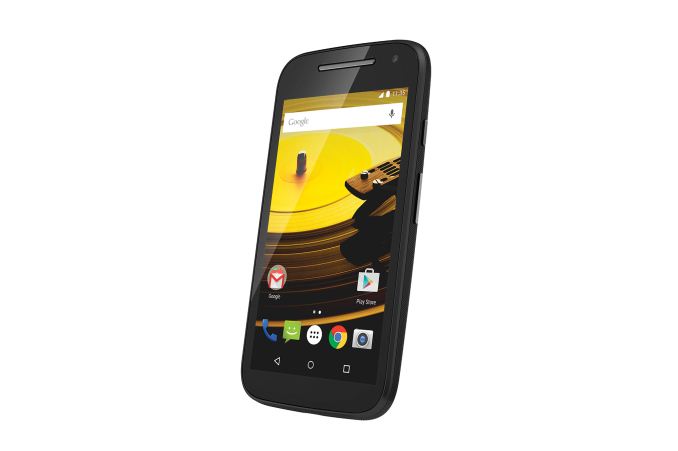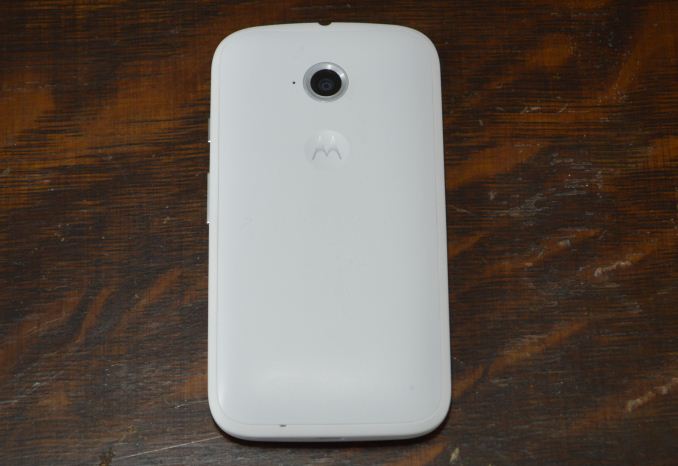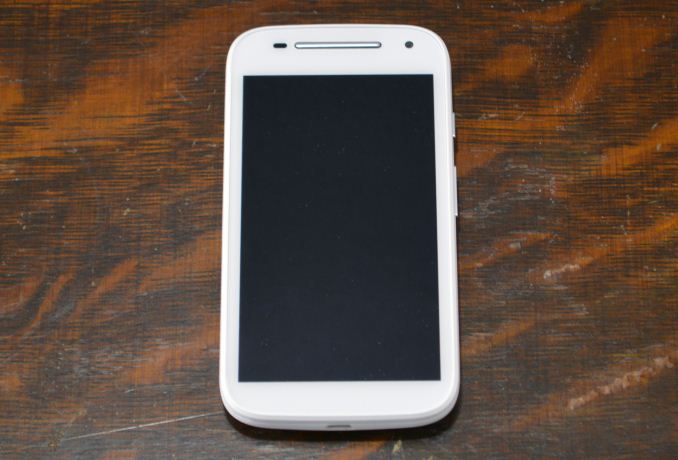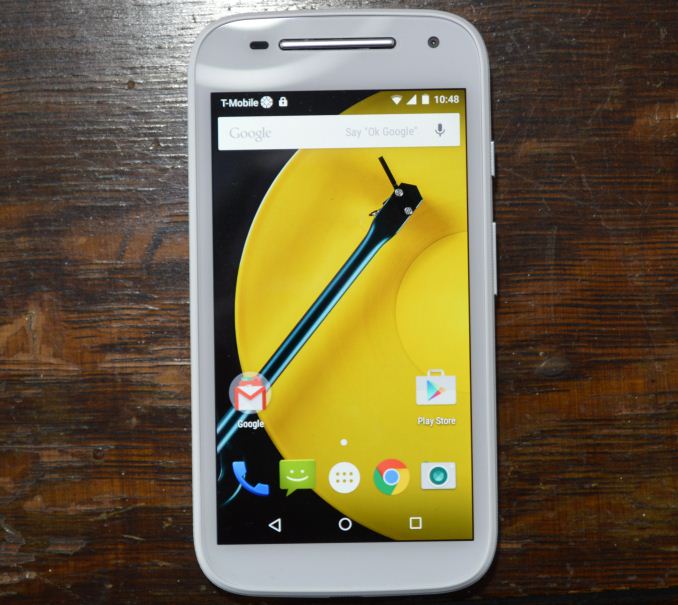Motorola Announces Moto E (2015): Cortex-A53 + LTE For $149
by Andrei Frumusanu on February 25, 2015 3:00 PM EST- Posted in
- Smartphones
- Motorola
- Mobile
- Moto E
- Moto E (2015)

Today Motorola has announced the launch and immediate availability of the 2015 version of the Moto E, the latest member of the company’s line of low-end smartphones.
The 2015 edition of the Moto E is a pretty hefty upgrade of a phone launched just 9 months ago. In terms of design the new Moto E is generally a bigger, more powerful version of its predecessor, retaining the same rounded plastic design while enlarging the overall body slightly to house the larger 4.5" screen. Meanwhile Motorola has iterated on the 2014’s swappable back covers, with the 2015 featuring the ability to swap in one of the company’s newer grip shells, or the phone’s colored bands can be swapped out separately.
| Motorola's 2015 Low-End Smartphone Lineup | ||||||
| Motorola Moto E (2015) | Motorola Moto E (2014) | Motorola Moto G (2014) | ||||
| SoC | Qualcomm Snapdragon 410 (MSM8916) 4x Cortex A53 @ 1.2GHz Adreno 306 at 400MHz (LTE model XT1527) or Qualcomm Snapdragon 200 (MSM8x10) 4x Cortex A7 @ 1.2GHz Adreno 302 at 400MHz (3G models) |
Qualcomm Snapdragon 200 (MSM8x10) 2x Cortex A7 @ 1.2GHz Adreno 302 at 400MHz |
Qualcomm Snapdragon 400 (MSM8x26) 4x Cortex A7 @ 1.2 GHz Adreno 305 at 450MHz |
|||
| RAM/NAND | 1GB LPDDR3 8GB NAND & MicroSD |
1GB LPDDR2 4GB NAND & MicroSD |
1GB LPDDR3 8/16GB NAND & MicroSD |
|||
| Display | 4.5" 960x540 LCD | 4.3" 960x540 LCD | 5" 1280x720 IPS LCD | |||
| Dimensions | 129.9 x 66.8 x 12.3mm 145g |
124.38 x 64.8 x 12.3mm 142g |
141.5 x 70.7 x 11.0 mm 149g | |||
| Camera | 5MP (2592 х 1944) Rear Facing w/Auto Focus, F/2.2 aperture VGA (640x480) Front Facing |
5MP (2592 х 1944) Rear Facing w/Fixed Focus | 8MP (2592 х 1944) Rear Facing 2MP (1280x720) Front Facing |
|||
| Battery | 2390 mAh (9.08 Whr) | 1980 mAh (7.52 Whr) | 2070 mAh (7.87 Whr) | |||
| OS | Android 5.0 | Android 4.4.2 | Android 4.4.4 | |||
| Connectivity | 802.11 b/g/n + BT 4.0, USB2.0, GPS/GNSS | 802.11 b/g/n + BT 4.0, USB2.0, GPS/GNSS | 802.11 b/g/n + BT 4.0, USB2.0, GPS/GNSS | |||
| SIM Size | Micro-SIM | Micro-SIM (Dual SIM SKU) |
Micro-SIM | |||
The phone is being released in two versions. The first being the LTE model which primarily targets the US market in its LTE frequency bands. There are also a pair of 3G versions, with one again targeted at the US and the other more globally, with the big difference being the US 3G version's support of the 1700MHz AWS frequency bands for HSPA+.
| Motorolla E (2015) Model Breakdown | ||||||
| Region | GSM | UMTS/HSPA+ | LTE | |||
| 4G LTE - US GSM (XT1527) |
850, 900, 1800, 1900 | 850, 1700, 1900 | 2, 4, 5, 7, 12, 17 | |||
| US GSM (XT1511) | 850, 900, 1800, 1900 | 850, 1700, 1900 | - | |||
| Global GSM (XT1505) | 850, 900, 1800, 1900 | 850, 900, 1900, 2100 | - |
|||
Priced at $149, the LTE version features a Qualcomm Snapdragon 410 processor, which supplies both the quad-core Cortex-A53 CPU and the Category 4 LTE modem. The 3G versions will be launching later at $119 – the biggest difference here is the use of a Snapdragon 200 series SoC with a quad-core Cortex-A7 CPU instead of the newer A53 Snapdragon 410. Having received the LTE version from Motorola, for our purposes we’ll be focusing on the LTE version.
Likely the single biggest draw for the 2015 Moto E over the 2014 is the inclusion of LTE support, which is a first for a low-end Motorola phone, and in fact is something even the higher-tier 2014 Moto G did not include. Driven by the 9x25 modem integrated into the Snapdragon 410, this gives the Moto E Cat 4 LTE capabilities along the most common North American bands.
Meanwhile users of either version will also quickly notice the larger screen, which sees a slight bump to 4.5”, up from 4.3” in the 2014 version. Though larger, the resolution though remains entry-level at qHD (960x540) pixels, so pixel density has decreased some compared to the 2014 version. Helping to drive this larger display and to take advantage of the larger phone body is a 2390mAh battery, 410mAh more than in last year's model. Even accounting for the larger screen battery life should be improved over the 2014 version – particularly stand-by time – however we’ll have to give the phone a complete rundown to see what the real-world gains are.
Next to the screen and new to this year’s version is a front-facing VGA (640x480, 0.3MP) camera. The 2014 model skipped out on a camera entirely for cost reasons, and while this camera is of limited use, it should be reasonable enough for selfies and video chat on an entry level phone. Meanwhile the rear facing camera is still 5MP, however it’s now capable of auto focus versus last year’s fixed focus camera. As for video recording, this camera is used to record at 720p30, a significant step up from the 2014’s FWVGA (854x480) recording capabilities.
Storage has also seen a bump up, going from 4GB on-board to 8GB on-board, and users still looking for more can add more storage via microSD. The accompanying RAM on the other hand remains at 1GB, though it’s now LPDDR3 as opposed to LPDDR2.
Finally, the phone is shipping with Android 5.0 Lollipop, making it the first Motorola-branded phone to ship with Android 5.0 out of the factory and joining Motorola’s other phones which recently received the OS as an update. Motorola doesn’t specify whether they’re using a 32-bit or 64-bit version of the OS, however a quick check of the phone finds that it's running the 32-bit version of Android. Which given the fact that the 2015 Moto E is available with both Cortex-A53 and Cortex-A7 based SoCs, it makes sense that the company is sticking to 32-bit throughout.
We will be putting the new Moto E through its paces in the coming weeks, but so far it looks like a solid update to the Moto E lineup. At $149 for the LTE it does end up debuting at $20 more expensive than the previous version in what’s a very price sensitive market, so it will be interesting to see how consumers respond to the higher price. But LTE tends to be a big draw.
Shipping today, US customers can order the LTE version of the phone from Motorola’s website. Meanwhile international customers can look forward to Motorola rolling out the phone to more than 50 countries in the Americas, Europe, and Asia.
Source: Motorola





 Side - White_thumb.jpg)
 Back - Black_thumb.jpg)
 Back - White_thumb.jpg)
 Back Dynamic - Black_thumb.jpg)
 Front - White_thumb.jpg)
 Front Dynamic - Black_thumb.jpg)








29 Comments
View All Comments
jeffkibuule - Wednesday, February 25, 2015 - link
For $150, that's actually not too bad.Mondozai - Wednesday, February 25, 2015 - link
The Moto E is primarily aimed at markets like India, where even an extra 10 dollars MSRP can make or break a purchase.LTE in such markets make no sense. Most of them don't even have LTE except for in a few token spots in the largest cities if even that.
It's still not even a 720p screen. The Huawei Holly is a whopping $50 dollars cheaper, it has 720p and 3G, which is most relevant. Oh, did I mention it's $50 dollars cheaper? The Moto E 2015 is far too overpriced for its market segment. Even the Xiaomi Redmi Note is on a similar scale.
In Indian currency, the 150 dollars is about 10K rupees, which is where the Mi Note is. Which has 4G(if you really must have it) and a 720p 5.5 inch screen and over 3000 mAh battery life. Why would you get a phone like the Moto E for the same price with less battery life, crappier screen, smaller screen and no distinct advantage?
There are many other examples of low-budget phones which are better. Motorola gotta step it up.
Mondozai - Wednesday, February 25, 2015 - link
Oh and then there's the Lenovo A6000. It is cheaper by about 30 dollars MSRP. It has LTE(again unnecessary for the budget end, but whatever), 720p, 5 inch screen and same battery.Cheaper and better specs. Jeff if you think the Moto is a good buy you're only revealing your ignorance.
fic2 - Wednesday, February 25, 2015 - link
Or, he actually read the article:"The phone is being released in two versions. The first being the LTE model which primarily targets the US market in its LTE frequency bands. There are also a pair of 3G versions, with one again targeted at the US and the other more globally, with the big difference being the US 3G version's support of the 1700MHz AWS frequency bands for HSPA+."
jjj - Wednesday, February 25, 2015 - link
2 things to note, the 3G version is much slower with it's A7 cores and LTE is not a premium feature in 2015 anymore.When Qualcomm owned the LTE market they milked it hard but now others are pushing LTE and prices are far more reasonable. Since the first post mentions India i'll add that India does have TDD-LTE (a little bit anyway, in India even 3G coverage is poor) so it's easier for the China phone makers to attack that LTE market and something that other phone makers need to factor in.
ChennaiBoi - Friday, February 27, 2015 - link
The 3G version is priced at INR 6,999 (~$113) which is exactly same as the Honor Holly and Lenovo A6000. Yes on paper the Holly and A6000 have a better screen. But check the reviews and you would see that the Moto E(2014) screen had better brightness and color reproduction than these two.Moto has addressed many of the issues of the 2014 issues like FF camera, front cam and very low internal storage.
Plus it comes with Lollipop out of box which is a big advantage against other phones that are still on Kitkat. I was slightly disappointed they are still sticking to S200 whereas they could have thrown in a S400 for the 3G version.
But overall a good phone and should again sell in millions in India just like the 2014 version.
P.S: I have both Moto G(2013) and Moto E (2014). So I have first hand experienced the UX improvement in the handsets with OS upgrade
icrf - Wednesday, February 25, 2015 - link
I don't think this phone is intended for India. The LTE bands are catered towards the US market. Regardless of what markets past Moto E versions targeted, the new LTE one is probably aimed at prepaid US customers buying phones off-contract.gonchuki - Thursday, February 26, 2015 - link
Why would anyone want to carry a reasonable sized phone instead of a 5.5 inch slab that doesn't fit in your pocket unless you use cargo pants? Yeah, those crazies picking the smaller phone they can easily carry around even on tight jeans, I don't get them. /sMaxpower2727 - Thursday, February 26, 2015 - link
I use a 5.5" phone, I don't wear cargo pants, and yet somehow I have no issues at all fitting the phone in my pocket. Such drama.mkozakewich - Thursday, February 26, 2015 - link
I can comfortably carry my 7" tablet in my jeans pocket. Not all of us are as small as you are.